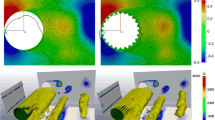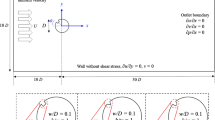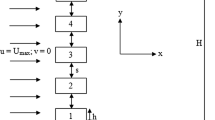Abstract
This paper presents a CFD study about the effect of the V and U grooves in the flow over four cylinders in diamond shape configuration at subcritical flow conditions (Re = 41000). The k-ε Realizable turbulence model was implemented to fully structured hexahedral grids with near-wall refinements. Results showed that the numerical model was able to reproduce the impinging flow pattern and the repulsive forces present in the lateral cylinders of the smooth cylinder array. As a consequence of the flow alignment induced by the grooves, a jet-flow is formed between the lateral cylinders, which could cause an important vortex induced vibration effect especially in the rear cylinder. The magnitudes of the shear stresses at the valleys and peaks for the V grooved cylinders were lower than those of the U grooved cylinders, but the separation points were delayed due the U grooves presence. It is discussed the presence of a blowing effect caused by counter-rotating eddies located near the grooves peaks that cause a decrease of the shear stresses in the valleys, and promote them at the peaks.
Similar content being viewed by others
References
LAM K., LO S. A visualization study of cross-flow around four cylinders in square configuration[J]. Journal of Fluids ana Structures, 1992, 6(1): 109–131.
LAM K., Li J. and CHAN K. et al. Flow pattern and velocity field distribution of cross-flow around four cylinders in a square configuration at a low Reynolds number[J]. Journal of Fluids and Structures, 2003, 17(5): 665–679.
LAM K., LI J. and SO R. Force coefficients and Strouhal numbers of four cylinders in cross flow[J]. Journal of Fluids and Structures, 2003, 18(3): 305–324.
LAM K., ZOU L. Experimental study and large eddy simulation for the turbulent flow around four cylinders in an in-line square configuration[J]. International Journal of Heat and Fluid Flow, 2009, 30(2): 276–285.
WANG X., GONG K. and LIU H. et al. Flow around four cylinders arranged in a square configuration[J]. Journal of Fluids ana Structures, 2013, 43(6): 179–199.
FARRANT T., TAN M. and PRICE W. A cell boundary element method applied to laminar vortex-shedding from arrays of cylinders in various arrangements[J]. Journal of Fluids ana Structures, 1999, 14(3): 375–402.
LAM K., GONG W. and SO R. Numerical simulation of cross-flow around four cylinders in an in-line square configuration[J]. Journal of Fluids ana Structures, 2008, 24(1): 34–57.
ZOU Lin, LIN Yu-feng and LU Hong. Flow patterns and force characteristics of laminar flow past four cylinders in diamond arrangement[J]. Journal of Hydrodynamics, 2011, 23(1): 55–64.
WALSH M. Turbulent boundary layer drag reduction using riblets[J]. American Institute of Aeronautics and Astronautics, 1982, 6(11): 769–787.
KO N., LEUNG Y. and CHEN J. Flow past V-groove circular cylinders[J]. AIAA Journal, 1987, 25(6): 806–811.
LEUNG Y., KO N. Near wall characteristics of flow over grooved circular cylinder[J]. Experiments in Fluids, 1991, 10(6): 322–332.
LIM H., LEE S. Flow control of circular cylinders with longitudinal grooved surfaces[J]. AIAA Journal, 2002, 40(10): 2027–2035.
LIM H., LEE S. PIV measurements of near wake behind a U-grooved cylinder[J]. Journal of Fluids and Structures, 2003, 18(1): 119–130.
BREUER M. A challenging test case for large eddy simulations: High Reynolds number circular cylinder flow[J]. International Journal of Heat and Fluid Flow, 2000, 21(5): 648–654.
WOLFSTEIN M. The velocity and temperature distribution of one-dimensional flow with turbulence augmentation and pressure gradient[J]. International Journal of Heat and Mass Transfer, 1969, 12(3): 301–318.
CHEN H., PATEL V. Near-wall turbulence models for complex flows including separation[J]. AIAA Journal, 1988, 26(6): 641–648.
SAYERS A. Flow interference between four equispaced cylinders when subjected to a cross flow[J]. Journal of Wind Engineering and Industrial Aerodynamics, 1988, 31(1): 9–28.
LAM K., FANG X. The effect of interference of four equispaced cylinders in cross flow on pressure and force coefficients[J]. Journal of Fluids ana Structures, 1995, 9(2): 195–214.
CHOI H., MOIN P. and KIM J. Direct numerical simulation of turbulent flow over riblets[J]. Journal of Fluid Mechanics, 1993, 255: 505–539.
Author information
Authors and Affiliations
Corresponding author
Additional information
Biography: ALONZO-GARCÍA A. (1980-), Male, Ph. D., Professor
Rights and permissions
About this article
Cite this article
Alonzo-García, A., C. Gutiérrez-Torres, C.d., Jiménez Bernal, J.A. et al. RANS simulations of the U and V grooves effect in the subcritical flow over four rotated circular cylinders. J Hydrodyn 27, 569–578 (2015). https://doi.org/10.1016/S1001-6058(15)60518-2
Received:
Revised:
Published:
Issue Date:
DOI: https://doi.org/10.1016/S1001-6058(15)60518-2




